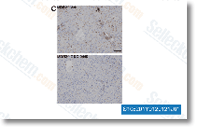Previously we now have shown that mTNF taken care of myeloid cells exhibit enhanced intracellular ROS and decreased cell survival, To show an association involving intra cellular ROS degree and cell death in L929 fibrosarcomas, cells incubated with unique TNF isoforms had been mea sured making use of CM H2DCFDA, L929 cells incubated with FxB16mTNF resulted in a 60% raise in CM H2DCFDA fluorescence, indicating an ceramide dependent signaling pathway initiated by SMase activity, To determine the precise pathway re sponsible for activation of mitochondrial ROS production we analyzed degree of active RIP1 by evaluating its phos phorylation in L929 or RAW 264. 7 during the presence of FxB16cont or FxB16mTNF by immunoblot evaluation. As proven in Figure 5B, therapy of the two cell lines with fixed membrane expressing tumor cells, FxB16mTNF didn’t increase the degree of RIP 1 phosphorylation.
To additional improve inside the level of ROS, Even more more, incubation of L929 selleck inhibitor cells with ROS scavenger N acetyl cysteine reduced mTNF mediated ROS level, This was followed by four fold reduce in LDH release in mTNF treated L929 cells supplied with NAC, Inhibition of mitochondrial respiratory chain decreased mTNF mediated ROS generation Following we sought to determine the source of ROS in re sponse to mTNF in L929 cells. There’s report of nicotinamide adenine dinucleotide phosphate oxidase 1 and mitochondria since the two leading supply of TNF induced ROS manufacturing, To undertake so, the NADPH dependent oxidase plus the mitochondrial respiratory chain complicated II have been blocked utilizing DPI and TTFA respectively. The NADPH dependent oxidase inhibitor DPI didn’t inhibit the ROS manufacturing induced by mTNF and even further had no result for the LDH leakage, Having said that, addition of TTFA into L929 cells cocultured with mTNF expressing tumor cells, decreased CM H2DCFDA oxidation and LDH release, These information recommended that mitochondria are the supply of mTNF induced ROS generation and cell death.
Membrane TNF mediated ROS manufacturing entails ceramide pathway TNFR mediated mitochondrial ROS generation is usually induced by RIP 1 kinase activity or by a involved with the generation of mitochondrial ROS we assessed cell death by MTT assay with L929 cells incu bated with fixed tumor cells, with recommended you read or devoid of the RIP 1 inhibitor necrostatin, The inhibitor didn’t result in any alter in L929 cell death when incubated with FxB16mTNF when compared to handle. There may be proof to help the function of ceramide like a 2nd messenger of TNF activated cells involved with activation of programmed necrosis, Next we evalu ated the role of ceramide signaling in TNF induced ROS manufacturing and survival.
Addition of myriocin, a cer amide inhibitor, diminished the cell death observed in L929 cells incubated with FxB16mTNF to a level comparable to  that observed with cells incubated with management tumor cells, Furthermore addition of DMAP, a CAPK inhibi tor, decreased mTNF induced ROS by 60%, Percentage of LDH leakage was also reduced from 276% in mTNF handled cells to 163% in mTNF taken care of cells provided with DMAP, These findings suggested that mTNF induced mitochondrial ROS generation needs protein kinase exercise related with ceramide.
that observed with cells incubated with management tumor cells, Furthermore addition of DMAP, a CAPK inhibi tor, decreased mTNF induced ROS by 60%, Percentage of LDH leakage was also reduced from 276% in mTNF handled cells to 163% in mTNF taken care of cells provided with DMAP, These findings suggested that mTNF induced mitochondrial ROS generation needs protein kinase exercise related with ceramide.
Natural Products
The latest published issue of Journal of Natural Products
